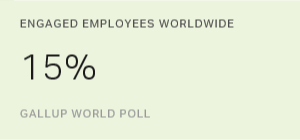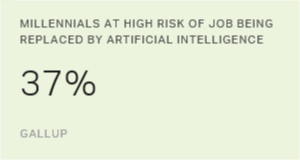This is the third article in a three-part interview series. The first article appears here, and the second article appears here.
In 2007, the 5,000 union employees of DTE Energy had among the lowest employee engagement scores in Gallup's global database.
By 2017, those scores were among the highest.
Behind this remarkable turnaround at the Detroit-based utility company was an act of leadership bold in practice but kind of obvious in philosophy. At a frustratingly unproductive meeting between union leaders and management, DTE's Chairman and CEO, Gerry Anderson, stood up and reminded them who was responsible for DTE workers: every single person in the room. And that they all needed to do better for their members and the employees.
Union and company leaders were united, Anderson reminded them, in wanting a safe, productive, engaging workplace. Leadership's job, union or executive, is to make it happen. They needed to focus on that. Period.
That sounds simple, obvious and easy -- but if it were, all companies with union employees would have engagement rates like DTE's. And many CEOs have said the same thing to union leaders, but without achieving the engagement, safety and productivity improvements that DTE has.
Clearly, Anderson accomplished something that many other leaders have not, try though they might. In the following CEO-to-CEO conversation between Anderson and Gallup Chairman and CEO Jim Clifton, Anderson describes that meeting, the frustration that provoked him to speak and the honest self-examination that resulted from it. His experience and hard-won wisdom provide a blueprint for genuine union/management partnerships -- and that's a lesson many CEOs are anxious to learn.

Create Exceptional Workers
Strengthen employee performance with a culture of engagement.
Clifton: Tell me about your relationship with the union leaders at DTE.
Anderson: We meet triannually with our union presidents and some of their right-hand people, to keep them informed about what's going on in the business, just as we do with our company leadership. And they used to be OK meetings. But in 2013, my leadership team and I wanted to talk to the union leaders about what we'd been doing with engagement.
Clifton: Like what?
Anderson: I've learned that in this job, maybe the key role is to energize people with a common cause. If you want to change something, you need to start shining your energy on it and it changes. We'd been focusing our people on purpose and aspirations to draw their energy -- which is another word for engagement -- for a long time. And our engagement results were really improving for nonunion employees. But we weren't seeing the same movement with union employees. And I believe that there should be no difference in the work experience or engagement levels of these two groups. Yes, collective bargaining changes the terms and conditions, but the work environment should be the same.
So, at one of our meetings in 2013, I was scheduled to talk with our union leaders about purpose and aspiration. We were coming off the best safety month in our company's history and I go into this union leadership meeting -- we open with a discussion of safety. I'm thinking this is going to be a celebration. People will be going, "Wow, this is great!" Not so. The safety presentation ends, and all I hear are complaints, criticism and generally what wasn't going well in safety from the 30 or 40 union leaders in the room.
I sat there watching it, just shaking my head. Then I said to our VP of HR, "I am not talking to this group about purpose and aspiration. Not in this environment. In fact, I don't even know what these meetings are about!" And my HR VP said, "Well, why don't you skip the polite dance and tell them that?"
So I did.
Clifton: Right then?
Anderson: Right then. I walked up and said, "I came here with an agenda today, and I'm scrapping it. I have no idea what I just witnessed. We just had the best month of safety in our company's history and rather than a celebration of how we're winning together, all I hear are complaints? These are your members who are safer! My employees, your members." I told them that I wanted them to talk amongst themselves about what we should be trying to accomplish at these gatherings. Because this wasn't working.
Now, I'm usually a calm guy, but I have to admit I was fed up. So my tone was pretty direct. But then, something started to happen. Union leaders at their tables were saying things like, "We ought to find a way to work together on safety," and, "Our members' engagement rate is a problem." And I said, "That's an indictment of me, but it's an indictment of you, too. They're your people. But they're mine, too."
Then one of them said he was embarrassed by the Gallup results and, "We ought to fix that." The meeting ended with three big agenda items: First, we're going to keep our people safe. Second, we're going to have them like working here, excited about being members of your unions and our company. Third was continuous improvement. After that, we started focusing all of our meetings pretty much 100% on those items. That's where we started shining our energy, all of us.
Clifton: So that day was a big turning point?
Anderson: That was the first time the union leaders believed that this was real. They engaged in a different way in the wake of that. We started holding our meetings differently. We were honest with them, and they were honest with us. For example, we sat down and just asked, "What's the problem with our engagement?" They said some of our front-line leaders were really bad.
Clifton: How did you take that?
Anderson: Well, at first I was a little edgy, thinking that they were trying to walk away from the agenda. And then I started thinking, "They're probably right." There were leaders who didn't get the importance of engagement, and we really did have some work to do.
Clifton: Rather than just blindly defending the supervisors?
Anderson: Yeah. And I do believe that leadership drives almost everything. So I told them, "We're going to go to work on our leadership." And they were like, "Well, that's the first time we've heard this."
But we did it. We went to work. We told our supervisors and leaders that ultimately their job is leading people. We'll work with you, we'll train you, we'll give you all the skills and tools we can, but if you can't draw people's energy, you're not a leader. The union saw us changing the quality of our leaders. They saw we were serious. Then they became serious. And that's when they went to work just like we did.
Clifton: You know, sometimes declaring war is the easy thing to do. The hard thing to do is go make it work.
Anderson: Now look, we're not perfect, but having union employee engagement go from the 4th percentile in Gallup's global database in 2007 to the 94th percentile this past spring -- that's a big trip! But you have to make it work. And you have to admit it if you're a part of what's broken.



